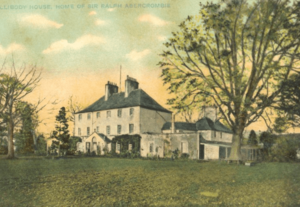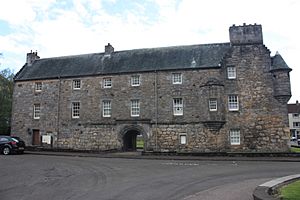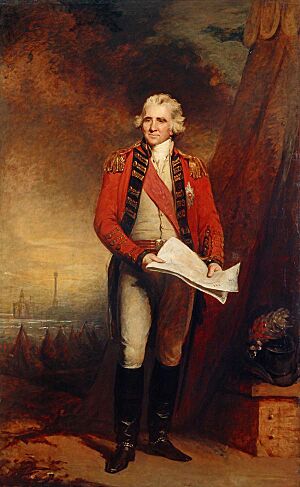Ralph Abercromby facts for kids
Quick facts for kids
Sir Ralph Abercromby
|
|
|---|---|
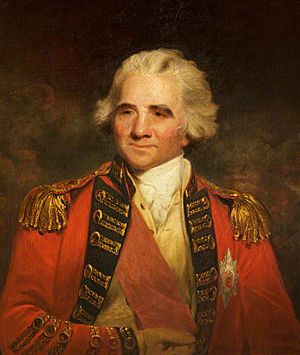
Sir Ralph Abercromby, by John Hoppner
|
|
| Born | 7 October 1734 Menstrie, Clackmannanshire, Scotland |
| Died | 28 March 1801 (aged 66) Alexandria, Ottoman Egypt |
| Buried | (35°54′10″N 14°31′12″E / 35.90278°N 14.52000°E) |
| Allegiance | Kingdom of Great Britain United Kingdom |
| Service/ |
British Army |
| Years of service | 1756–1801 |
| Rank | Lieutenant-General |
| Battles/wars |
|
| Relations | Alexander Abercromby, Lord Abercromby (brother) Sir Robert Abercromby (brother) |
| Other work | Member of Parliament Governor of Trinidad Lord Lieutenant of Clackmannanshire |
Lieutenant General Sir Ralph Abercromby (7 October 1734 – 28 March 1801) was a famous British soldier and politician. He became a lieutenant-general in the British Army. He was also the Governor of Trinidad and the Commander-in-Chief in Ireland. He was well-known for his actions during the French Revolutionary Wars, especially in the Egyptian campaign. Many people consider his battle plans to be among the most daring and brilliant in British military history.
Contents
Early Life and Education
Ralph Abercromby was born on October 7, 1734, at Menstrie Castle in Scotland. He was the second son of George Abercromby, a lawyer, and Mary Dundas. His family later moved to Tullibody House, which they had built around 1700. Ralph spent most of his childhood there.
He had a private tutor first, then went to Mr. Moir's school in Alloa. At age 12, he attended Rugby School until he was 18. From 1752 to 1753, he studied at the University of Edinburgh. He then went to Leipzig University in Germany to study law, planning to become a lawyer.
Military Career Begins
When Ralph returned from Germany, he decided he wanted to be a soldier. In 1756, he joined the 3rd Dragoon Guards as a cornet. He fought in the Seven Years' War, where he learned a lot from the famous military leader Frederick the Great. This experience shaped his skills as a general.
He moved up the ranks, becoming a lieutenant-colonel in 1773 and a colonel in 1780. In 1781, he became colonel of a new regiment, the King's Irish infantry. When that regiment was disbanded in 1783, he retired for a while. He also served in Parliament as a representative for Clackmannanshire from 1774 to 1780.
Fighting in Europe and the Caribbean
When France declared war on Great Britain in 1793, Abercromby returned to duty. He led a group of soldiers in the Netherlands under the Duke of York. He was wounded during a retreat in 1794.
In 1795, he was chosen to lead an expedition to the West Indies. He was made a Knight of the Bath and Lieutenant Governor of the Isle of Wight. This was a reward for his service and an encouragement to lead the army in the Caribbean.
In 1796, Abercromby arrived in Barbados. He helped put down rebellions in Saint Vincent and Grenada. He also led the capture of Saint Lucia from the French. His forces successfully took control of the fort at Morne Fortune.
After these victories, Abercromby secured control of Demerara and Essequibo in South America, and the island of Trinidad. However, a major attack on San Juan, Puerto Rico, in 1797 was not successful.
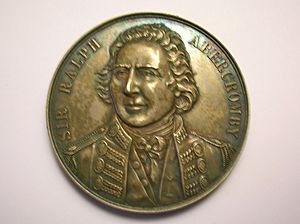
Commander in Ireland and Holland
Abercromby returned to Europe and was promoted to Lieutenant-general. He also became a Member of Parliament again. In 1798, he was made Commander-in-Chief of the forces in Ireland. At that time, Ireland was facing a rebellion and possible French invasion.
Abercromby tried to improve the army's discipline and protect the people from military abuse. He wanted to make sure the civil government had control, not just the military. However, he felt he didn't get enough support from the Irish government. Because of this, he resigned his command. Many people in Ireland were sad to see him go.
After a short time as commander in Scotland, Abercromby led troops again in 1799. This time, it was for the Anglo-Russian invasion of Holland against the French-controlled Dutch Republic. Abercromby successfully landed his troops at Callantsoog and pushed the enemy back. The British and Russian forces advanced, and part of the Dutch fleet surrendered. However, the mission eventually failed, and the Anglo-Russian forces had to withdraw.

The Egyptian Campaign
In 1801, Abercromby was sent with an army to take Egypt back from France. His past experiences in the Netherlands and the West Indies prepared him well for this mission. He managed to get his army to Egypt in good health and with all the supplies they needed, despite many challenges.
The landing of his troops at Aboukir was very difficult. The French fought hard, but Abercromby's soldiers managed to land. This action is considered one of the bravest and most brilliant achievements of the British army.
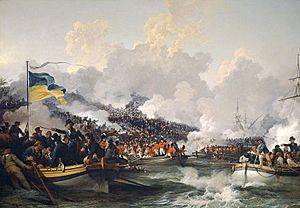
Battle of Alexandria, 1801
After successfully landing his army at Aboukir, Abercromby led his troops inland. On March 21, 1801, they faced a French counter-attack at Alexandria. The French general, Jacques-François Menou, wanted to stop the British advance.
The British army was spread out, with their right side near the sea and their left near a lake. The French attacked early in the morning. The main attack hit the British reserve division, especially the 28th (North Gloucestershire) Regiment of Foot. The British fought back and stopped the first attack.
A confused fight happened in some old ruins. British regiments like the 42nd Regiment of Foot fought bravely. The French cavalry also attacked the British. During the battle, Abercromby was briefly captured by French soldiers but was quickly rescued. He was shot in the thigh, which would later be fatal, but he stayed on the field leading his troops until the battle was won.
The British won the battle, forcing Menou to retreat into the city of Alexandria. Later, in August, British forces surrounded Alexandria and captured the city. This victory ended French control over Egypt and Syria.
Death and Legacy
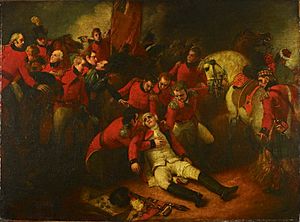
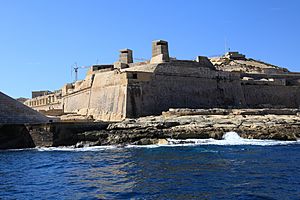
During the Battle of Alexandria, Abercromby was shot in the thigh. He didn't leave the field until the battle was won and the enemy was retreating. He was then carried to the flagship, HMS Foudroyant. The bullet could not be removed, and he died seven days later, on March 28, 1801.
His old friend, the Duke of York, praised Abercromby. He said Abercromby's discipline, care for his troops, strong spirit, and brave actions were an example for all.
Sir Ralph Abercromby was buried in St. John's Bastion within Fort Saint Elmo in Valletta, Malta. The British military renamed it Abercrombie's Bastion to honor him.
Recognition and Family
The British Parliament voted to build a monument in Abercromby's honor in St Paul's Cathedral in London. His wife was given the title Baroness Abercromby and a yearly pension.
Places like Abercromby Place in Edinburgh and Abercromby Square in Liverpool are named after him. There is also a primary school and a pub in Tullibody named after him.
On November 17, 1767, Abercromby married Mary Anne Menzies. They had seven children. Four of their sons became Members of Parliament, and two served in the military.
- Hon. Anne Abercromby (1768–1832)
- Hon. Mary Abercromby (1773–1825)
- Hon. Catherine Abercromby (1780–1841)
- George Abercromby, 2nd Baron Abercromby (1770–1843)
- General Hon. Sir John Abercromby (1772–1817)
- James Abercromby, 1st Baron Dunfermline (1776–1858)
- Lt.-Col. Hon. Alexander Abercromby (1784–1853)
Popular Culture
Many books have been written about Sir Ralph Abercromby. A pub in Manchester called "Sir Ralph Abercromby" is named after him. Another pub in London, "General Abercrombie," also features his portrait.
Three ships in the British Navy have been named HMS Abercrombie in his honor, using a slightly different spelling of his name.
|
See also
 In Spanish: Ralph Abercromby para niños
In Spanish: Ralph Abercromby para niños


